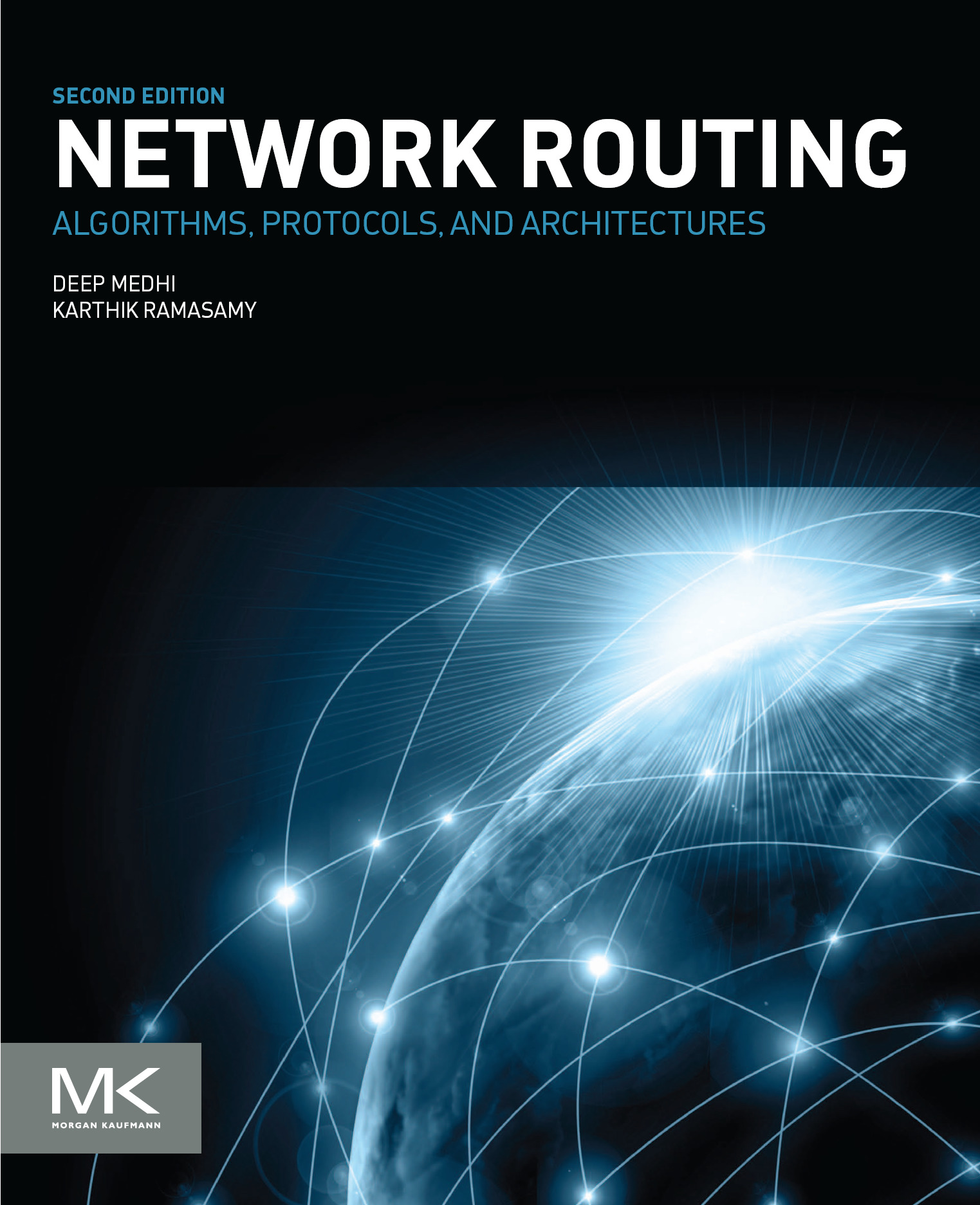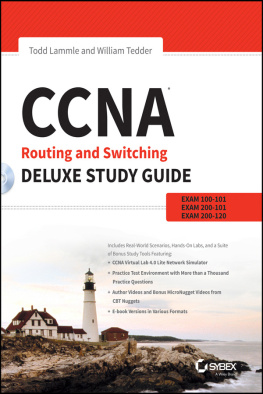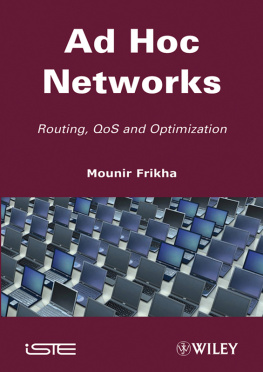Medhi Deep - Network Routing
Here you can read online Medhi Deep - Network Routing full text of the book (entire story) in english for free. Download pdf and epub, get meaning, cover and reviews about this ebook. year: 2017, publisher: Elsevier Science, genre: Children. Description of the work, (preface) as well as reviews are available. Best literature library LitArk.com created for fans of good reading and offers a wide selection of genres:
Romance novel
Science fiction
Adventure
Detective
Science
History
Home and family
Prose
Art
Politics
Computer
Non-fiction
Religion
Business
Children
Humor
Choose a favorite category and find really read worthwhile books. Enjoy immersion in the world of imagination, feel the emotions of the characters or learn something new for yourself, make an fascinating discovery.

- Book:Network Routing
- Author:
- Publisher:Elsevier Science
- Genre:
- Year:2017
- Rating:3 / 5
- Favourites:Add to favourites
- Your mark:
- 60
- 1
- 2
- 3
- 4
- 5
Network Routing: summary, description and annotation
We offer to read an annotation, description, summary or preface (depends on what the author of the book "Network Routing" wrote himself). If you haven't found the necessary information about the book — write in the comments, we will try to find it.
Network Routing — read online for free the complete book (whole text) full work
Below is the text of the book, divided by pages. System saving the place of the last page read, allows you to conveniently read the book "Network Routing" online for free, without having to search again every time where you left off. Put a bookmark, and you can go to the page where you finished reading at any time.
Font size:
Interval:
Bookmark:

Second edition
Deep Medhi
Karthik Ramasamy

- Tables in Chapter 1
- Tables in Chapter 2
- Tables in Chapter 3
- Tables in Chapter 4
- Tables in Chapter 5
- Tables in Chapter 6
- Tables in Chapter 7
- Tables in Chapter 8
- Tables in Chapter 9
- Tables in Chapter 10
- Tables in Chapter 11
- Tables in Chapter 12
- Tables in Chapter 13
- Tables in Chapter 14
- Tables in Chapter 15
- Tables in Chapter 17
- Tables in Chapter 19
- Tables in Chapter 20
- Tables in Chapter 21
- Tables in Chapter 22
- Tables in Chapter 23
- Tables in Chapter 24
- Tables in Chapter 25
- Tables in Chapter 26
- Tables in Appendix B
- Figures in Chapter 1
- Figures in Chapter 2
- Figures in Chapter 3
- Figures in Chapter 4
- Figures in Chapter 5
- Figures in Chapter 6
- Figures in Chapter 7
- Figures in Chapter 8
- Figures in Chapter 9
- Figures in Chapter 10
- Figures in Chapter 11
- Figures in Chapter 12
- Figures in Chapter 13
- Figures in Chapter 14
- Figures in Chapter 15
- Figures in Chapter 16
- Figures in Chapter 17
- Figures in Chapter 18
- Figures in Chapter 19
- Figures in Chapter 20
- Figures in Chapter 21
- Figures in Chapter 22
- Figures in Chapter 23
- Figures in Chapter 24
- Figures in Chapter 25
- Figures in Chapter 26
- Figures in Appendix A
- Figures in Appendix B
Routing: Basics and Foundations
Outline
Internet Routing
Outline
Router Architecture & Design
Outline
Routing in Reservation-Oriented Networks
Outline
Appendices, Bibliography, and Index
Outline
Morgan Kaufmann is an imprint of Elsevier
50 Hampshire Street, 5th Floor, Cambridge, MA 02139, United States
Copyright 2018 Elsevier Inc. All rights reserved.
No part of this publication may be reproduced or transmitted in any form or by any means, electronic or mechanical, including photocopying, recording, or any information storage and retrieval system, without permission in writing from the publisher. Details on how to seek permission, further information about the Publisher's permissions policies and our arrangements with organizations such as the Copyright Clearance Center and the Copyright Licensing Agency, can be found at our website: www.elsevier.com/permissions.
This book and the individual contributions contained in it are protected under copyright by the Publisher (other than as may be noted herein).
Notices
Knowledge and best practice in this field are constantly changing. As new research and experience broaden our understanding, changes in research methods, professional practices, or medical treatment may become necessary.
Practitioners and researchers must always rely on their own experience and knowledge in evaluating and using any information, methods, compounds, or experiments described herein. In using such information or methods they should be mindful of their own safety and the safety of others, including parties for whom they have a professional responsibility.
To the fullest extent of the law, neither the Publisher nor the authors, contributors, or editors, assume any liability for any injury and/or damage to persons or property as a matter of products liability, negligence or otherwise, or from any use or operation of any methods, products, instructions, or ideas contained in the material herein.
Library of Congress Cataloging-in-Publication Data
A catalog record for this book is available from the Library of Congress
British Library Cataloguing-in-Publication Data
A catalogue record for this book is available from the British Library
ISBN: 978-0-12-800737-2
For information on all Morgan Kaufmann publications visit our website at https://www.elsevier.com/books-and-journals

Publishing Director: Jonathan Simpson
Acquisition Editor: Brian Romer
Editorial Project Manager: Ana Claudia A. Garcia
Production Project Manager: Punithavathy Govindaradjane
Designer: Mark Rogers
Typeset by VTeX
To Karen: the distance cost is now infinite and yet does not feel so
To Deuta: the man who new infinity, probabilistically
To Maa: who has the indefinable ability to see infinity
To Neiloy & Robby: there are infinite paths take the one you like
Deep/Debu/Dad
To my wife, Monika, with love
Karthik
Lawrence Landweber Past John P. Morgridge Chair and Past Department Chairman, Computer Science Department, University of WisconsinMadison, Fellow, Association for Computing Machinery, Recipient of IEEE Award on International Communication, Former President and Chair of the Board of Trustees, Internet Society
My involvement with computer networking started with TheoryNet (1977), an email system for theoretical computer scientists. Later (1981) I helped lead the CSNET (computer science network) project which eventually connected most academic and many industrial computer research groups. In those early days, our efforts were primarily focused on providing connectivity and being able to use applications such as email , ftp , and telnet . However, even in the simple (by today's standards) environment of the 1970s and early 1980s (Arpanet, CSNET, other experimental Internet networks), getting routing right turned out to be quite challenging.
I was fortunate to be part of the NSFNET regional/backbone model development. This is when I began to fully understand the significance of routing in a large-scale multi-domain network and, in particular, the central role of policy issues in such a decentralized environment. As the Internet has become global in scale and ubiquitous over the past decade, routing has become ever more important. Packets must be forwarded efficiently from one end of the world to the other with minimal perception of delay. This has required tremendous efforts on many fronts: how to evolve routing protocols for large-scale loosely-coupled networking environments, how to engineer a network for efficient routing from an operational point of view, how to do efficient packet processing at routers, and how to effectively take into account the complexity of policy issues in the determination of routes. And while over the past two decades there have been many exciting advances, much work remains to be done.
In parallel, we have seen tremendous advances in traditional telephony. The underlying telecommunication system has changed from analog to digital and has incorporated the latest advances in optical technologies and, more recently, voice over IP. Throughout these revolutionary changes, routing has continued to play a critical role.
Font size:
Interval:
Bookmark:
Similar books «Network Routing»
Look at similar books to Network Routing. We have selected literature similar in name and meaning in the hope of providing readers with more options to find new, interesting, not yet read works.
Discussion, reviews of the book Network Routing and just readers' own opinions. Leave your comments, write what you think about the work, its meaning or the main characters. Specify what exactly you liked and what you didn't like, and why you think so.







